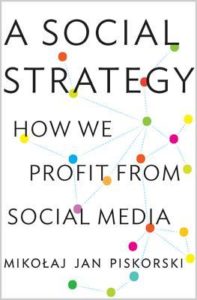Mikolaj Jan Piskorski’s “A Social Strategy: How We Profit from Social Media” was published in 2014, which is quite a few lifetimes ago in the tech world, but I checked it out anyway.
It’s an academic text, looking at the success and failure of different social media platforms and a few companies attempting to take advantage of them through the lens of sociology.
It can get quite wonky at times, but I like wonky.
It also attempts to give advice to anyone looking to establish a new social network or use existing social networks to either save or make money.
In economics, there is a concept called “market failure” in which economic transactions do not happen or happen inefficiently due to some reason or another.
Piskorski notes that there are also categories of “social failure,” social
interactions that people seek and would better their situations if they happened but cannot accomplish in the off-line world. Social failures are about the interactions that do not occur, which is an interesting way to look at things.
For example, single people might find it difficult to meet others, and so dating platforms such as Ok Cupid and eHarmony provide social solutions. He analyzed how each differed in their approaches and how one succeeded due to providing a superior, more effective solution.
Besides “meet” failures, there are also “friend” failures, in which a person might find it difficult to share information or social support in an existing relationship. There’s a chapter in which Zynga is a case study that focuses on this context.
And much like how in economics there can be transaction costs as the underlying reason for a market failure, there are economic and social costs that prevent or inhibit otherwise good social interactions from happening. He categorizes them as breadth, display, search, and communication.
It’s a fascinating analysis, which is especially relevant if you are trying to create a new social app or platform. Piskorski juxtaposed Facebook and the Japanese social media platform mixi, as well as LinkedIn and Friendster, explaining how each tackled their solutions to the above social failures differently and how those different approaches created different results.
He argues that a social solution needs to address both the economic AND the social causes of interaction costs. Otherwise, it will be ineffective. In fact, he argues that social solutions that provide breadth, display, search, and communication functionalities will do better than others that only provide a few.
But, he also says that there are often trade-offs that need to be made. Some solutions increase the costs of certain functionalities. Facebook will never replace LinkedIn because Facebook would need to offer a way for people to meet strangers. In fact, Facebook once did offer a way to search and find strangers, but it had the side-effect that individuals in relationships used this functionality to cheat on their partners, which reduced the effectiveness of the “friend” solution that Facebook is offering. So Facebook removed the functionality, leaving LinkedIn as the dominant platform to meet people on.
Well, what if you aren’t setting up your own social network but want to take advantage of existing networks for your own business?
Piskorski also talks about the concept of the “social strategy.” In general, organizations use either low cost or high willingness-to-pay strategies. If you can lower the former without lowering the latter, or if you can increase the latter without increasing the former, you have a competitive advantage. Piskorski goes one step further to say that a social strategy involves leveraging people willing to take on business tasks for free in order to indirectly lower costs or increase willingness-to-pay.
A social strategy is different from a digital strategy, which is basically taking the familiar activity of broadcasting content at an audience and applying it online. A social strategy involves identifying and implementing a solution that solves unmet economic and social needs. In short, if you can introduce people to each other AND get them to do things for you for free, you are leveraging social media for your organization’s benefit.
The generalized framework used:
1) A viable social strategy seeks to increase a company’s profitability
2) by improving interactions between people
3) if they undertake a set of corporate functions for free
Piskorski discusses ways an organization can develop a strategy that fits the framework, as well as identifying what problems can occur if the strategy does not focus on how the proposed solution can both provide business value and social utility.
I am not sure exactly how different the social networking world looks in 20202 compared to 2014, and I would love to see if Piskorski has a new, updated analysis.
But “A Social Strategy” provided a set of principles and a framework that I think I can use to figure out how to more effectively market my games. Instead of randomly tweeting and posting on Facebook and wondering why I’m not getting the results I want, I can be a bit more analytical and thoughtful. I can be more purposeful and deliberate. And I can recognize when a strategy isn’t working that doesn’t involve merely noticing a lack of sales.

